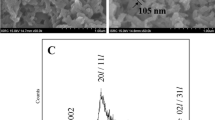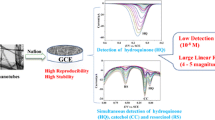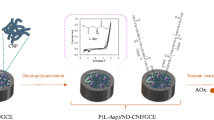Abstract
We present an approach on the electrodeposition of gold nanoparticles (AuNPs) on a carbon fiber microelectrode (CFME) followed by deposition of nickel(II) tetrasulfonated phthalocyanine (p-NiTSPc) film by electropolymerization to form CFME-AuNPs/p-NiTSPc, for the sensitive determination of butylhydroxyanisole (BHA) using cyclic voltammetry (CV) and differential pulse voltammetry (DPV). Atomic force microscopy (AFM), scanning electron microscopy (SEM), and energy-dispersive X-ray spectroscopy (EDX) were used to characterize the topography, morphology, and elemental composition of CFME, CFME-AuNPs, CFME-p-NiTSPc, and CFME-AuNPs/p-NiTSPc, respectively. Additionally, the electrochemical impedance spectroscopy (EIS) technique was employed to evaluate the charge-transfer rate of the tested sensors. To establish the optimal conditions for the electroanalysis of BHA, various parameters were investigated, including the potential scan rate, pH, and electrolysis potential. CFME-AuNPs/p-NiTSPc demonstrated the highest BHA signal, corresponding to the highest active surface area of 0.025 cm2, compared to CFME-p-NiTSPc (0.024 cm2), CFME-AuNPs (0.022 cm2), and CFME (0.021 cm2). In a phosphate buffer solution (PBS, 0.1 M; pH 3), a good linear relationship (R2 = 0.998) was observed between peak current intensities and BHA concentrations in the range of 10–80 µM, resulting to a detection limit (LOD) of 3.60 µM (S/N = 3) and a quantification limit (LOQ) of 12 µM (S/N = 10). The analytical HPLC technique was also tested for BHA determination within the concentration range of 5.55–55.48 µM and the obtained LOD was calculated to be 4.41 µM. The potential interference of certain species that could affect the BHA oxidation signal was also evaluated, followed by the application of CFME-AuNPs/p-NiTSPc in real water and Mitosyl ointment samples. The recovery values of BHA were acceptable, ranging from 96 to 99% and demonstrating that the developed sensor is highly sensitive and effective for detecting trace amounts of BHA.
Graphical abstract












Similar content being viewed by others
Data availability
The original data used in this study can be obtained from the submitting author if requested.
References
Xu X, Liu A, Hu S, Ares I, Martínez-Larrañaga MR, Wang X, Martinez M, Anadon A, Martínez MA (2021) Synthetic phenolic antioxidants: metabolism, hazards and mechanism of action. Food Chem 353:129488. https://doi.org/10.1016/j.foodchem.2021.129488
Prasad VU, Divakar TE, Hariprasad K, Sastry CSP (1987) Spectrophotometrie determination of some antioxidants in oils and fats. Food Chem 25:159–164. https://doi.org/10.1016/0308-8146(87)90065-3
Naji KM, Thamer FH, Numan AA, Dauqan EM, Alshaibi YM, D’souza MR (2020) Ferric-bipyridine assay: a novel spectrophotometric method for measurement of antioxidant capacity. Heliyon 6:e03162. https://doi.org/10.1016%2Fj.heliyon.2020.e03162
Capitán-Vallvey LF, Valencia MC, Nicolás EA (2004) Solid-phase ultraviolet absorbance spectrophotometric multisensor for the simultaneous determination of butylated hydroxytoluene and co-existing antioxidants. Anal Chim Acta 503:179–186. https://doi.org/10.1016/j.aca.2003.10.027
Munteanu IG, Apetrei C (2021) Analytical methods used in determining antioxidant activity: a review. Int J Mol Sci 22:3380. https://doi.org/10.3390/ijms22073380
Xiu-Qin L, Chao J, Yan-Yan S, Min-Li Y, Xiao-Gang C (2009) Analysis of synthetic antioxidants and preservatives in edible vegetable oil by HPLC/TOF-MS. Food Chem 113:692–700. https://doi.org/10.1016/j.foodchem.2008.07.072
Kim J-M, Choi S-H, Shin G-H, Lee J-H, Kang S-R, Lee KY, Lim H-S, Kang TS, Lee O-H (2016) Method validation and measurement uncertainty for the simultaneous determination of synthetic phenolic antioxidants in edible oils commonly consumed in Korea. Food Chem 213:19–25. https://doi.org/10.1016/j.foodchem.2016.06.053
Saad B, Sing YY, Nawi MA, Hashim N-H, Ali ASM, Saleh MI, Sulaiman SF, Talib KM, Ahmad K (2007) Determination of synthetic phenolic antioxidants in food items using reversed-phase HPLC. Food Chem 105:389–394. https://doi.org/10.1016/j.foodchem.2006.12.025
Mateos R, Vera S, Díez-Pascual AM, Paz SAM (2017) Graphene solid phase extraction (SPE) of synthetic antioxidants in complex food matrices. J Food Comp Anal 62:223–230. https://doi.org/10.1016/j.jfca.2017.07.006
Sin DWM, Wong YC, Mak CY, Sze ST, Yao WY (2006) Determination of five phenolic antioxidants in edible oils: method validation and estimation of measurement uncertainty. J Food Comp Anal 19:784–791. https://doi.org/10.1016/j.jfca.2005.12.005
Cacho JI, Campillo N, Viñas P, Hernández-Córdoba M (2016) Determination of synthetic phenolic antioxidants in edible oils using microvial insert large volume injection gas-chromatography. Food Chem 200:249–258. https://doi.org/10.1016/j.foodchem.2016.01.026
Gupta MK, Anand A, Asati A, Thati R, Katragunta K, Agarwal R, Mudiam MKR (2021) Quantitative determination of phenolic antioxidants in fruit juices by GC-MS/MS using automated injector port silylation after QuEChERS extraction. Microchem J 160:105705. https://doi.org/10.1016/j.microc.2020.105705
Ding M, Zou J (2012) Rapid micropreparation procedure for the gas chromatographic-mass spectrometric determination of BHT, BHA and TBHQ in edible oils. Food Chem 131:1051–1055. https://doi.org/10.1016/j.foodchem.2011.09.100
Delgado-Zamarreño MM, González-Maza I, Sánchez-Pérez A, Martínez RC (2007) Analysis of synthetic phenolic antioxidants in edible oils by micellar electrokinetic capillary chromatography. Food Chem 100:1722–1727. https://doi.org/10.1016/j.foodchem.2005.10.018
Aghdam AA, Majidi MR, Veladi H, Omidi Y (2019) Microfluidic-based separation and detection of synthetic antioxidants by integrated gold electrodes followed by HPLC-DAD. Microchem J 149:104059. https://doi.org/10.1016/j.microc.2019.104059
Jakubczyk M, Michalkiewicz S (2018) Electrochemical behavior of butylated hydroxyanisole and butylated hydroxytoluene in acetic acid solutions and their voltammetric determination in pharmaceutical preparations. Int J Electrochem Sci 13:4251–4266. https://doi.org/10.20964/2018.05.76
Caramit RP, Andrade AGF, Souza JBG, Araujo TA, Viana LH, Trindade MAG, Ferreira VS (2013) A new voltammetric method for the simultaneous determination of the antioxidants TBHQ and BHA in biodiesel using multi-walled carbon nanotube screen-printed electrodes. Fuel 105:306–313. https://doi.org/10.1016/j.fuel.2012.06.062
Lin X, Ni Y, Kokot S (2013) Glassy carbon electrodes modified with gold nanoparticles for the simultaneous determination of three food antioxidants. Anal Chim Acta 765:54–62. https://doi.org/10.1016/j.aca.2012.12.036
Wang P, Han C, Zhou F, Lu J, Han X, Wang Z (2016) Electrochemical determination of tert-butylhydroquinone and butylatedhydroxyanisole at choline functionalized film supported graphene interface. Sens Actuator B Chem 224:885–891. https://doi.org/10.1016/j.snb.2015.10.098
Oliveira TMBF, Becker H, Longhinotti E, De Souza D, De Lima-Neto P, Correia AN (2013) Carbon-fiber microelectrodes coupled with square-wave voltammetry for the direct analysis of dimethomorph fungicide in natural waters. Microchem J 109:84–92. https://doi.org/10.1016/j.microc.2012.03.032
Maringa A, Nyokong T (2014) The influence of gold nanoparticles on the electroactivity of nickel tetrasulfonated phthalocyanine. J Porphyrins Phthalocyanines 18:642–651. https://doi.org/10.1142/S1088424614500333
Berríos C, Marco JF, Gutiérrez C, Ureta-Zañartu MS (2009) Electro-oxidation of chlorophenols at glassy carbon electrodes modified with polyNi (II) complexes. Electrochim Acta 54:6417–6425. https://doi.org/10.1016/j.electacta.2009.06.017
Bako YFR, Tapsoba I, Pontié M, Chelaghmia LM (2018) Direct electrooxidation of 3-methyl-4-nitrophenol (MNP) at carbon fiber microelectrode (CFME). Int J Electrochem Sci 13:8056–8071. https://doi.org/10.20964/2018.08.35
Hou C, Luo Q, He Y, Zhang H (2021) Potentiostatic electrodeposition of gold nanoparticles: variation of electrocatalytic activity toward four targets. J Appl Electrochem 51:1721–1730. https://doi.org/10.1007/s10800-021-01604-7
Mbokou FS, Pontié M, Razafimandimby B, Bouchara JP, Njanja E, Tonle KI (2016) Evaluation of the degradation of acetaminophen by the filamentous fungus scedosporium dehoogii using carbon-based modified electrodes. Anal Bioanal Chem 408:5895–5903. https://doi.org/10.1007/s00216-016-9704-8
Mocak J, Bond AM, Mitchel S, Scollary G (1997) A statistical overview of procedures for determining the limits of detection and quantification: application to voltammetric and stripping techniques. Pure Appl Chem 69:297–302. https://doi.org/10.1351/pac199769020297
Analytical Methods Committee (1987) Recommendations for the definition, estimation and the use of the detection limit. Analyst 112:199–204
Hadjmohammadi MR, Ehsani M, Kamel K, Biparva P (2012) Application of experimental design for extraction of BHA and BHT from edible vegetable oil and their determination using HPLC. Q Sci Connect 1:7. https://doi.org/10.5339/connect.2012.7
Mbokou FS, Bako YFR, Ilboudo O, Karanga Y, Njanja E, Pontie M, Tapsoba I, Tonle KI, Djouaka R (2022) Sensitive carbon fiber microelectrode for the quantification of diuron in quality control of a commercialized formulation. Int J Anal Chem Article ID. https://doi.org/10.1155/2022/9994639
Sbaï M, Essis-Tome H, Gombert U, Breton T, Pontie M (2007) Electrochemical stripping analysis of ethyl-parathion (MPT) using carbon fiber microelectrodes (CFME) modified with combinations of poly-NiTSPc and Nafion® films. Sens Actuators B 124:368–375. https://doi.org/10.1016/j.snb.2006.12.051
Pontie M, Thouand G, De Nardi F, Tapsoba I, Lherbette S (2011) Antipassivating electrochemical process of glassy carbon electrode (GCE) dedicated to the oxidation of nitrophenol compounds. Electroanalysis 23:1579–1584. https://doi.org/10.1002/elan.201100082
Ferrari G-M, Foster WC, Kelly JP, Brownson CA, Banks EC (2018) Determination of the electrochemical area of screen-printed electrochemical sensing platforms. Biosensors 8:3–10. https://doi.org/10.3390/bios8020053
Hallam PM, Banks CE (2011) A facile approach for quantifying the density of defects (edge plane sites) of carbon nanomaterials and related structures. Phys Chem Chem Phys 13:1210–1213. https://doi.org/10.1039/C0CP01562H
Bruce PG, Lisowska-Oleksiak A, Los P, Vincent CA (1994) Electrochemical impedance spectroscopy at an ultramicroelectrode. J Electroanal Chem 367:219–283
Laviron E (1979) General expression of the linear potential sweep voltammogram in the case of diffusionless electrochemical systems. J Electroanal Chem Interf Electrochem 101:19–28. https://doi.org/10.1016/S0022-0728(79)80075-3
Ngouoko JJK, Tajeu KY, Temgoua RCT, Doungmo G, Doench I, Tamo AK, Kamgaing T, Osorio-Madrazo A, Tonle KI (2022) Hydroxyapatite/L-Lysine composite coating as glassy carbon electrode modifier for the analysis and detection of Nile Blue A. Materials 15:4262. https://doi.org/10.3390/ma15124262
Shetti NP, Nayak DS, Malode SJ, Kulkarni RM (2018) Fabrication of MWCNTs and Ru doped TiO2 nanoparticles composite carbon sensor for biomedical application. ECS J Solid State Sci Technol. https://doi.org/10.1149/2.0101807jss
Tajeu KY, Ymele E, Jiokeng ZSL, Tonle KI (2019) Electrochemical sensor for caffeine based on a glassy carbon electrode modified with an attapulgite/nafion film. Electroanalysis 31:350–356. https://doi.org/10.1002/elan.201800621
Yue X, Song W, Zhu W, Wang J, Wang Y (2015) In situ surface electrochemical co-reduction route towards controllable construction of AuNPs/ERGO electrochemical sensing platform for simultaneous determination of BHA and TBHQ. Electrochim Acta 138:126–139. https://doi.org/10.1016/j.electacta.2015.09.162
Roushani M, Sarabaegi M (2014) Electrochemical detection of butylatedhydroxyanisole based on glassy carbon electrode modified by iridium oxide nanoparticles. J Electroanal Chem 717–718:147–152. https://doi.org/10.1016/j.jelechem.2014.01.013
Zhao TGA, Wang ZS, Sun J (2016) Hierarchical triple-shelled porous hollow zinc oxide spheres wrapped in graphene oxide as efficient sensor material for simultaneous electrochemical determination of synthetic antioxidants in vegetable oil. Sens Actuators 235:707–716. https://doi.org/10.1016/j.snb.2016.05.137
Ziyatdinova GK, Ziganshina ER, Os’kina KS, Budnikov HC (2014) Voltammetric determination of sterically hindered phenols in surfactant—based self—organized media. J Anal Chem 69:750–757. https://doi.org/10.1134/S1061934814080140
Acknowledgements
We wish to thank Romain Mallet (Angers University, SCIAM, France) for recording SEM/AFM images and EDX spectra. We also thank the ISP (International Science Program) for its financial support to the African Network of Electroanalytical Chemists (ANEC). We are grateful to iMERMAID (Innovative solutions for Mediterranean Ecosystem Remediation via Monitoring and decontamination from Chemical Pollution) project funded by European Union for the financial support of the postdoctoral position of Dr. Serge MBOKOU at the Angers University.
Author information
Authors and Affiliations
Contributions
HHTB, EN, SFM, RTM, and IKT conducted the Lab work. HTB and SFM wrote the main manuscript. YFRB and MP did some experiments and characterizations. All authors reviewed the final version of the manuscript.
Corresponding author
Ethics declarations
Conflict of interest
The authors declare no competing financial interest.
Additional information
Publisher’s Note
Springer Nature remains neutral with regard to jurisdictional claims in published maps and institutional affiliations.
Supplementary Information
Below is the link to the electronic supplementary material.
Rights and permissions
Springer Nature or its licensor (e.g. a society or other partner) holds exclusive rights to this article under a publishing agreement with the author(s) or other rightsholder(s); author self-archiving of the accepted manuscript version of this article is solely governed by the terms of such publishing agreement and applicable law.
About this article
Cite this article
Tchoumi Bougna, H.H., Njanja, E., Foukmeniok Mbokou, S. et al. Electrochemical determination of butylhydroxyanisole (BHA) using a carbon fiber microelectrode modified by electrodeposition of gold nanoparticles and poly-NiTSPc film. J Appl Electrochem (2024). https://doi.org/10.1007/s10800-024-02093-0
Received:
Accepted:
Published:
DOI: https://doi.org/10.1007/s10800-024-02093-0




